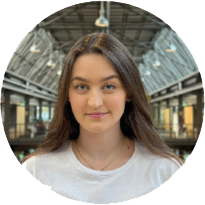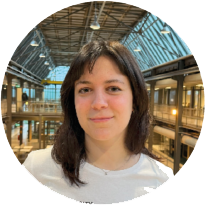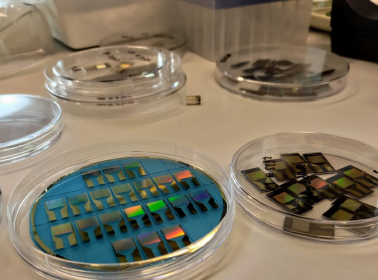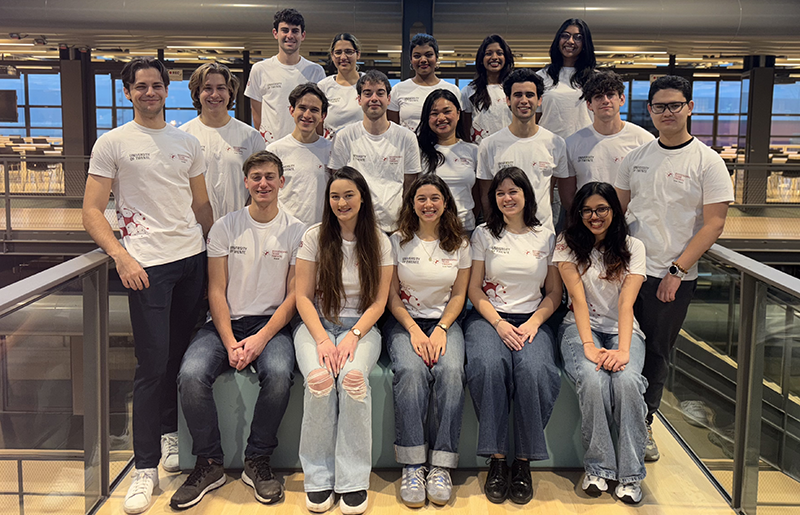Small Tech Big Impact
Cutting Edge Biosensor Design
In a world where technology and biology increasingly intersect, biosensors are emerging as game-changers in healthcare, diagnostics, and beyond. These sophisticated devices can detect and analyse biological data in real-time, unlocking insights into everything from glucose levels to early diagnosis. At the forefront of biosensor innovation is Biosensing Team, a student team transforming how we monitor and understand the human body. In this interview, the team shares the journey behind developing biosensor technology, its potential to revolutionize healthcare, and the challenges of competing at international student competition SensUs. Discover how they are bridging science and technology to shape a smarter, healthier future.

Can you introduce the Biosensing Team Twente and describe what challenges are you focused on?

Diana: The Biosensing Team Twente is a student team that combines innovation, education, and research to address real-world healthcare challenges. Our mission revolves around three core objectives. First, we aim to raise awareness about healthcare problems that require urgent attention but may not yet have widespread solutions. Second, we strive to develop simple, cost-effective devices to address these challenges. Finally, we provide a platform for students to gain experience in biomedical research, allowing them to develop their skills in a collaborative, startup-like environment.

Caterina: One of the most exciting parts of our work is our participation in the international SensUs competition, which brings teams from across the globe together to solve a clinical problem. This year, our challenge is Acute Kidney Injury, a condition that is both life-threatening and difficult to detect in its early stages. We’re tasked with developing a biosensor that can detect specific biomarkers in the blood related to this condition. The process is long and intense, requiring at least eight months of research and development, but it’s incredibly rewarding. This competition really pushes us to think critically and come up with innovative solutions to solve pressing healthcare problems.
What are biosensors and who can benefit from improving these medical products?

Jan Pieter: Biosensors are highly specialized devices that combine biological components with technological systems to detect and measure specific substances. The basic structure of a biosensor includes three key components: a biological recognition element, like antibodies or enzymes, which identifies the target analyte; a transducer, which converts this interaction into a measurable signal; and a signal processor, which amplifies and interprets the data. These devices have become indispensable tools in healthcare and beyond because of their ability to provide real-time, accurate, and reliable information.

Diana: The potential applications of biosensors are vast, and so are the benefits. In healthcare, for example, biosensors help patients by enabling early diagnosis of diseases, better management of chronic conditions, and even non-invasive monitoring. Imagine being able to measure blood glucose or hormone levels with a simple wearable device—this is the kind of innovation biosensors make possible. It could change how we approach managing health on a day-to-day basis. Healthcare providers also benefit, as biosensors streamline diagnostics, support precision medicine, allowing doctors and nurses to focus more on patient care.
What materials and techniques are involved in developing a biosensor?

Diana: Developing a biosensor is an intricate process that combines cutting-edge materials with advanced techniques. The biological recognition element is the heart of the biosensor and can include components like enzymes, antibodies, nucleic acids, or even whole cells. These biological elements are chosen for their ability to bind specifically to the target analyte and are immobilized on a support structure. The transducer plays a critical role in converting the biological interaction into a measurable signal. The type of transducer and the materials used depend on the signal type—for example, semiconductors for electrical signals, optical fibers for light based signals, or piezoelectric materials for mechanical signals. Nanomaterials, such as gold nanoparticles, graphene, or carbon nanotubes, are increasingly being used because they enhance the sensitivity and reduce the size of the device.

Jan Pieter: Beyond materials, techniques like photolithography, 3D printing, and microfluidics allow us to fabricate biosensors with high precision. Microfluidics is especially valuable because it enables the handling of tiny sample volumes, making biosensors more efficient and portable. Surface modification techniques, like plasma treatments, improve biocompatibility and stability, ensuring that the biosensor can function effectively under various conditions. Finally, machine learning and data analytics are used to interpret complex data, further enhancing the device’s accuracy and usability.
What are some of the technical challenges of biosensor development the industry and healthcare are facing?

Jan Pieter: One of the most significant challenges is achieving the high sensitivity and specificity needed to detect target analytes accurately. Biological samples like blood or saliva are incredibly complex, with many substances that can interfere with the detection of the target analyte. To make sure we get accurate results, we need to filter out any “noise” from these interfering substances. This requires significant research and fine-tuning. Another major issue is the stability of the biological recognition element. Components like enzymes or antibodies can degrade over time, losing their activity due to environmental factors like temperature, pH changes, or prolonged storage. Ensuring the biosensor remains reliable over its intended lifespan is a persistent challenge. Miniaturization and integration add another layer of complexity. Portable and wearable biosensors are in high demand, but shrinking components like transducers and signal processors without compromising their performance is no easy feat. Manufacturing scalability is another hurdle; what works in the lab doesn’t always translate smoothly to mass production.

Diana: Finally, cost remains a significant barrier. Many advanced materials and fabrication techniques are expensive, making the final product less accessible. Integrating biosensors with existing health technologies, like electronic health records or wearables, also requires sophisticated software, secure data transfer, and seamless interoperability— all of which can drive up costs.
What are the steps involved in developing a functional biosensor for the SensUs competition?

Jan Pieter: Developing a biosensor for the SensUs competition involves a well defined but challenging series of steps. The process begins with thorough research on the clinical problem and the biomarker associated with it. This stage is crucial because understanding the underlying biology and the specific requirements for detection shapes the entire development process. Next, we evaluate various sensing techniques to determine the most suitable method for detecting the biomarker. Once we’ve selected the sensing approach, we move on to surface functionalization. This involves preparing the sensor surface to ensure it interacts effectively with the target analyte. Techniques like Quartz Crystal Microbalance with dissipation monitoring (QCM-D) are used to test and optimize this step. Following this, we create the biosensor chip and design the full experimental setup. Calibration comes next, ensuring that the device can provide accurate and reproducible measurements. The final step is assembling all components into a fully functional biosensor, rigorously testing it, and preparing for the presentation at the competition.
What are the most significant technical challenges you’ve faced in developing your biosensor, and how have you addressed them?

Diana: One of the biggest technical challenges we’ve faced is ensuring continuity during measurements. When working with biosensors that rely on chips where multiple samples flow through, maintaining accuracy over time can be tricky. This is especially true when transitioning between samples or measurements. Any residue left behind by a previous sample or an additional cleaning substance can interfere with the next reading, potentially skewing results. This issue becomes even more critical when designing a wearable biosensor, where the goal is continuous or real-time monitoring in a practical, user-friendly form. Introducing a separate cleaning step or substance could complicate the design, increase cost, or make the device less portable and efficient.

Jan Pieter: To address this, we’ve explored materials and designs that minimize contamination and residue build-up. For instance, we’ve optimized the surface properties of the chip using advanced coatings that reduce adhesion of biological or chemical residues. These surface modifications help ensure that samples flow through smoothly without leaving behind substances that could interfere with subsequent measurements.
Additionally, we’ve focused on refining the fluid dynamics within the chip. By improving the design of the flow channels, we’ve been able to reduce stagnation points where residues are more likely to accumulate. While these solutions have improved the performance, achieving full continuity during measurements is still a work in progress. We’re continuing to test and iterate on designs to ensure that our biosensor can deliver accurate, reliable results over extended periods without manual intervention.
How are biosensors, such as yours, evaluated within a student competition structure?

Caterina: The SensUs competition evaluates biosensors on four separate criteria. First, there’s an Innovation Award, which covers how the device looks, functions, and achieves its purpose. This criteria only assess the concept, especially evaluating how cutting-edge it is. The accuracy and functionality of the device are assessed during a Testing Event, where every team is given a number of samples and have to measure the biomarker’s concentration in each of them. This award is critical—our biosensor must reliably detect the target analyte under specified conditions. In addition to technical performance, the Translation potential of the device is evaluated. To do this, we’re required to present a business case outlining a 10-year plan for bringing the device to market. This includes exploring its feasibility, potential impact, and commercial viability. Lastly, there’s a Public Inspiration vote, where we engage with the public to showcase our work and gain support. Social media and public outreach play a big role here!
After the competition, what are the next steps for your biosensor?

Diana: The future of the biosensor depends on the competition’s theme and its outcomes. Sometimes, the problem is extended into the next year with added challenges, like making the device wearable. If that doesn’t happen, the biosensor typically becomes the intellectual property of the team. In some cases, past ideas have evolved into PhD research projects, but they could even lead to the creation of startups. This flexibility allows us to explore various paths for continuing the work we’ve started during the competition.
Biosensor research and development by BTT

How many people are part of the team and how do they collaborate to achieve the team’s goals?

Diana: Our team is organized into two primary components: the core group and the board, each playing a critical role in achieving our goals. The core group focuses on the technical aspects of the project, particularly the development of the biosensor. This involves extensive research, experimentation, and innovation to design and build a functional, competitive device. The board, on the other hand, ensures the administrative and organizational side of the team runs smoothly. They manage everything from finances and scheduling to communication with external stakeholders, making sure we stay on track and have the resources we need to succeed.

Caterina: Within the core group, we’ve divided responsibilities into specialized sub-teams, each focusing on a key area of the biosensor’s development. For example, the chemistry team works on surface functionalization and biomarker interactions, while the chip and device design team focuses on creating the physical structure and integrating the necessary components. The experiments and analysis team handles testing, calibration, and data collection to ensure our biosensor performs as expected. Beyond the technical side, we also have a business case team, which prepares a comprehensive plan for how the device could be brought to market, addressing both feasibility and long-term impact. Lastly, the social media team helps us connect with the wider community, sharing our progress and generating excitement about our work, which is crucial for competitions where public support can make a difference.

Diana: The board complements these efforts by taking care of the “behind the scenes” work that keeps the team operational. Each board member has a defined role. The chair oversees everything and ensures cohesion between the core group and the board. The secretary manages planning, meeting agendas, and documentation, ensuring efficient communication and organization. The treasurer is responsible for budgeting and financial management, making sure we allocate resources wisely. Other key roles on the board include external relations, who build and maintain partnerships with sponsors and other stakeholders, and internal relations, who ensure seamless communication between team members, supervisors, and competition organizers. A Technical Manager is responsible for overseeing the lab work, ordering materials, and basically guide the team whenever they are in need. We also have a communication manager who handles publicity, social media campaigns, and public relations, which are vital for building our team’s reputation and visibility.

Caterina: In a team as big as ours it is necessary to ensure seamless collaboration between the core group and the board. This is achieved with regular meetings and clear communication. We hold regular check-ins to update each other on progress, identify roadblocks, and align our strategies. This ensures that everyone is on the same page and working toward a common goal. By having this structured approach, we’ve created a system where each member’s contributions—whether technical, managerial, or creative—are valued and integrated into the overall mission.
What are some of the most valuable lessons the team has learned from working in a multidisciplinary team?

Diana: One of the most important lessons we’ve learned is the immense value of diversity. Having team members from different fields of expertise and varied academic or cultural backgrounds enriches our approach to problem-solving. For example, someone with a chemistry background might view a challenge differently from an engineer or a business expert, and bringing those perspectives together often leads to innovative solutions that none of us could have developed alone. This diversity also teaches us to be open-minded and adaptable because we must consider viewpoints and methodologies outside our own expertise.

Caterina: Collaboration has also taught us that no contribution is too small or insignificant. Whether it’s a technical insight from the chemistry team, an innovative idea for social media outreach, or a creative solution for a business case, every team member’s input plays a vital role in our project’s overall success. We’ve learned the importance of clear communication and mutual respect, which are essential when working with such a wide range of disciplines. It’s not just about dividing tasks but ensuring that everyone’s efforts align with our shared goals.

Diana: Another key takeaway is the importance of patience and adaptability when merging different working styles. Each discipline comes with its own way of thinking and approaching problems, and learning to navigate those differences while maintaining productivity has been a challenge—but also a rewarding experience. We’ve become better at resolving conflicts constructively and finding common ground, which ultimately strengthens the team dynamic.
How do you see the future of the Biosensing Team Twente?

Diana: We’re excited for the future! In the short term, we aim to solidify our presence within the university network, increase our visibility, and strengthen the support system for our members. By engaging more actively with university activities, we hope to attract more talent and resources to ensure the longevity and growth of the team.

Caterina: Looking further ahead, our aspiration is to expand our scope beyond the SensUs competition. While the competition has been a fantastic platform for developing biosensors, we want to diversify our projects and tackle different challenges in the biosensing field simultaneously. This might include launching our own initiatives, exploring collaborations with other academic institutions, and even hosting competitions to inspire other student teams. Ultimately, we hope the team can contribute to advancements in healthcare, making diagnostics and monitoring more accessible, affordable, and effective for people worldwide.

Diana: By fostering collaborations with academic and industry leaders, we aim to remain at the forefront of biosensing innovation. We also hope to create a legacy where students continue to explore their potential, gain hands-on experience, and make a meaningful impact, both in healthcare and beyond.

